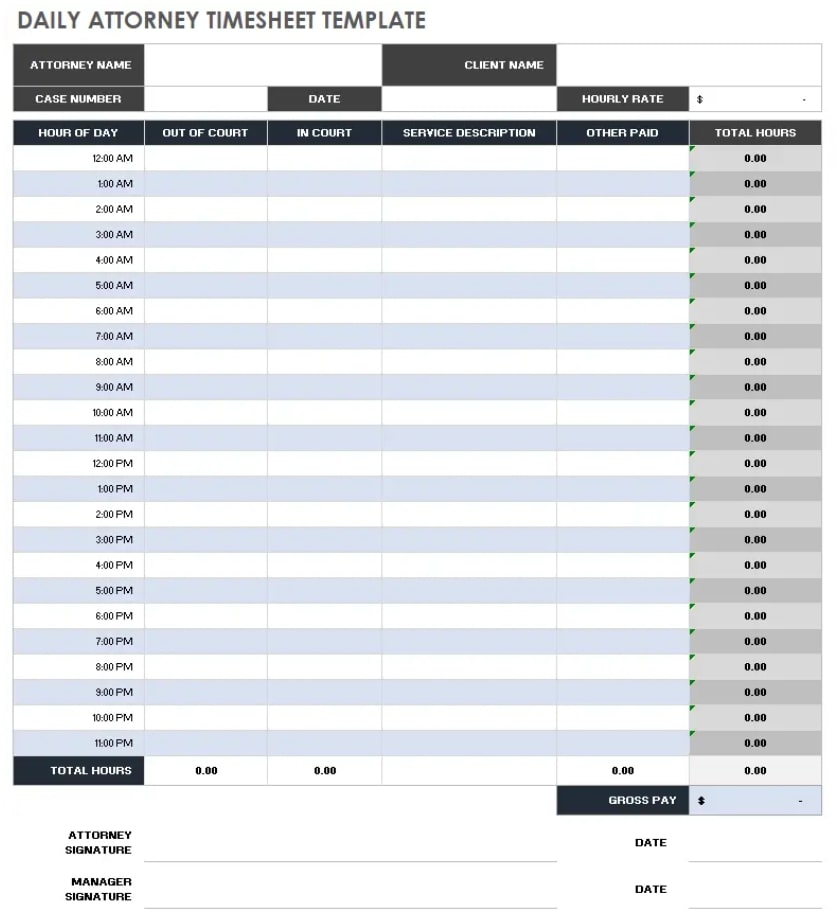In legal practice, timekeeping is a critical yet often challenging task. Precision in billing is crucial for a firm’s revenue, but amidst busy days filled with client meetings and court hearings, timekeeping can fall by the wayside. This leads to hasty or delayed time entries, affecting the overall profitability of a firm.
The issue compounds when attorneys use varied timekeeping methods, from traditional pen and paper to legal time tracking software. This diversity in approaches leads to inconsistency, causing headaches for managing partners and administrators who must consolidate these varying time records. Such disarray can lead to significant billable leakage and affect a firm’s recurring revenue.
Our guide on attorney billing timesheet templates aims to address these challenges head-on. We’ll answer commonly asked questions about timesheet templates, examine some PDF and Excel templates for lawyers, and offer practical tips to help you reclaim control over your timekeeping processes.
What Is a Timesheet for Billable Hours in a Law Firm?
A timesheet for billable hours in a law firm is a document that attorneys use to record the amount of time they spend on various client-related activities. These activities range from case research and drafting legal documents to client meetings and court appearances. The primary purpose of these timesheets is to track billable hours accurately, ensuring that the firm is billing clients fairly for the services they receive.
Why Do Attorneys Use Billing Timesheet Templates?
Attorneys use billing timesheet templates to bring some order and consistency to the timekeeping process. They typically include fields for date, client name, description of the task, and the time spent on each task. By standardizing the format, the firm can streamline the billing process and reduce the time spent on administrative tasks.
Despite these advantages, attorneys often find timesheet templates restrictive and cumbersome, especially when dealing with complex cases that don’t fit neatly into standard time increments or categories. Moreover, the manual process of filling out these templates is prone to errors and omissions, especially when done under time pressure. These challenges underscore the need for a more flexible and efficient solution to manage time tracking and billing in law firms.
How Do I Make a Professional Timesheet?
Creating a professional timesheet in a law office involves balancing the need for detailed record-keeping with the ease of use for attorneys. An easier solution here is to adopt time tracking software, which streamlines and standardizes timekeeping across an entire firm. However, if you are tasked with making a timesheet for your law office, you can follow these basic steps:
- Choose a Clear Layout: Start with a layout that is easy to read and fill out. Include columns for the date, client name, case number, a brief description of the task, and the time spent. The layout should allow attorneys to quickly enter information without confusion.
- Include Room for Details: There should be plenty of room to accurately describe every task performed. As noted repeatedly by the American Bar Association, invoices should show clients the value of your work and tell the story of their case progress. Vague descriptions can lead to misunderstandings with clients and even a bar complaint.
- Set Standard Time Increments: Decide on the time increments for billing (commonly in six-minute or fifteen-minute increments). Consistent increments ensure uniformity across all billings.
- Make It Accessible: The timesheet should be easily accessible to all attorneys in the firm. Consider a central location or a system where timesheets can be submitted electronically.
- Encourage Regular Updates: Encourage attorneys to update their timesheets daily. Catching up on a backlog of entries often leads to mistakes or forgotten billable activities. This issue is easily solved with time tracking software, as you can automatically track your time in real-time instead of manually after a long day.
While these steps guide in creating a professional timesheet, the process underscores several pain points. The time and effort spent in meticulous record-keeping, the challenge of accurate descriptions after exhausting workdays, and the risk of errors or omissions reflect a need for a more streamlined approach.
Still, many legal professionals may find themselves tempted to use an attorney timesheet template that’s free—but there are numerous problems with these that we’ll explore next.
Free Attorney Billing Timesheet Templates
A quick Google search for free attorney billing timesheet templates PDF reveals millions of results. However, many of these templates are seriously lacking and won’t help lawyers accurately track their time. Let’s examine a few popular ones.
Ask a few questions, and the problems with this template immediately jump out at you.
- What’s the lawyer billable hours rate?
- What happens if timekeepers with varying rates calculate their time?
- Which billing increments should attorneys use here?
- What happens if I need to use UTBMS codes for a particular task, entry, or line item?
- What if the attorney faces multiple interruptions during the same task?
- Should attorneys delineate between services and expenses, meetings, research, and communication?
This template doesn’t really make any of this clear, yet it’s been downloaded over 50,000 times. Some attorneys even complained that this template didn’t do any Excel calculations for them.
We hear you, Linda. The last thing attorneys have time for is adding up all their billable hours. But even free attorney billing timesheet templates in Excel are somewhat lacking. Let’s take a look.
Does Excel Have a Timesheet Template?
Excel offers numerous timesheet templates, but none of them are really sufficient for a law office. Take this Excel template, for example:

While this Excel spreadsheet does automatically calculate the hours spent on a task, it still doesn’t combat the numerous issues found in the PDF timesheet from above and presents new issues, like:
- Distinguishing between in-court and out-of-court hours is great, but it doesn’t account for other billable activities like expenses or travel time.
- You can’t track nonbillable hours if that’s something your firm wants to do to understand internal productivity.
- The hourly intervals may not match the actual time spent on tasks, as legal work can often be unpredictable and not fit neatly into hourly blocks.
- Some may accidentally use an older version of the template spreadsheet.
- Attorneys who want to do things differently may choose to “tweak” the spreadsheet a bit to “improve things,” leading to inconsistencies across the firm.
These problems are baked in. They’re an inherent part of using spreadsheets. And the more attention you divert to these problems, the less attention you can spend on your clients or practicing law. Ultimately, this is unfair to your firm, and it’s unfair to each of the timekeepers in your firm. This is where many start looking for a more efficient, automated solution.



 />i
/>i

